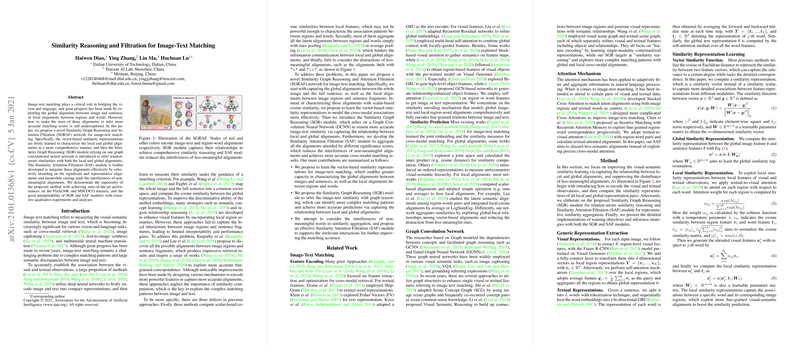Overview of "Similarity Reasoning and Filtration for Image-Text Matching"
This paper presents a novel approach to the challenging problem of image-text matching, introducing the Similarity Graph Reasoning and Attention Filtration (SGRAF) network. The fundamental contribution lies in leveraging both local and global alignments to comprehensively characterize image-text similarities, a critical enhancement over existing methodologies. The paper proposes two significant modules: Similarity Graph Reasoning (SGR) and Similarity Attention Filtration (SAF), designed to refine image-text similarity assessments by addressing previously underexplored facets of alignment utilization.
Key Innovations and Methodologies
- Similarity Representation Learning: The paper innovates by transitioning from scalar-based cosine similarity to vector-based similarity representations. This shift allows for a nuanced modeling of cross-modal associations, capturing the intricate details of regional and semantic alignment between images and textual descriptions.
- Similarity Graph Reasoning (SGR): Central to the SGRAF network, the SGR module employs a Graph Convolution Neural Network (GCNN) to facilitate complex similarity reasoning. By constructing a graph with nodes representing local and global alignments, the SGR module captures interdependencies among alignments, subsequently updating these nodes iteratively to enhance similarity prediction accuracy.
- Similarity Attention Filtration (SAF): Recognizing that not all alignments contribute equally to meaningful similarity computation, the SAF module is designed to filter out noise by selectively attending to significant alignments. This filtration process enhances discriminative power by suppressing less informative alignments.
Experiments and Results
The paper supports the proposed methodology with extensive experimental validation on benchmark datasets, Flickr30K and MSCOCO. The SGRAF network achieves state-of-the-art performance, evidenced by notable improvements in retrieval precision. The results underscore the effectiveness of integrating SGR and SAF modules—both individually and synergistically—in capturing complex image-text relationships. Key numerical outcomes from the experiments include significant improvements in Recall at 1 (R@1) for both sentence and image retrieval tasks, compared to existing approaches such as VSRN and SCAN.
Theoretical and Practical Implications
The SGRAF network addresses critical gaps in image-text matching by incorporating sophisticated mechanisms for fine-grained relationship reasoning. Theoretically, this approach enriches the understanding of cross-modal retrieval by demonstrating the benefits of comprehensive reasoning mechanisms over simplistic alignment measures. Practically, the implications extend to enhanced performance in applications such as multimedia retrieval, image captioning, and interactive systems requiring robust visual-semantic processing.
Future Directions
The research suggests potential avenues for further exploration, including the extension of graph reasoning capabilities to account for temporal dynamics in video-text scenarios, and the application of SAF principles to other multi-modal contexts. Additionally, investigating the scalability of SGRAF to larger datasets and more complex scenes could provide further insights into its generalizability and robustness.
In summary, "Similarity Reasoning and Filtration for Image-Text Matching" presents a sophisticated framework that refines the image-text matching paradigm through deep graph-based reasoning and attention mechanisms, fostering advancements in both theoretical foundations and applied AI systems in the field of visual-semantic integration.
